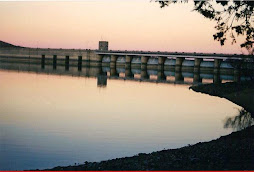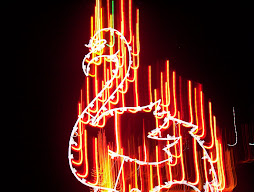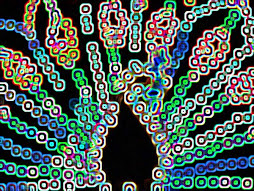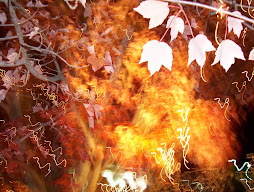Fukushima - What They Aren't Saying From Rense. Excerpts:
Pouring water on those reactors may keep them from getting worse - but it doesn't make them any better. And it creates the potential of another earthquake dumping millions of gallons of radioactive water all over the Pacific. They can't continue to create highly radioactive water at the rate of 21 cubic meters per hour for 200 years but the minute they stop the fuel goes critical again. There is no way to stop it except burning it up all at once with a few nukes.
So this report, which makes the situation sound less and less serious as the days pass, isn't telling the full story. Part of it simply isn't true. They have been pumping that amount of water every day for months now but they reported 60,000 tonnes on April 11 and the total amount in the facility has officially remained at 'a little less than 70,000 tonnes' ever since. That cannot be unless they are dumping it in the ocean and lying about it.
Did I read that smoke is still coming from two of the reactors? Yep. So the problem still exists in a big way - it's just been relegated to the back page.
Data monitor failed at Japan's nuclear plant, report says
A monitoring system at Japan's damaged nuclear plant failed in the power outage which took out the plant's cooling systems after the March quake and tsunami, depriving authorities of vital data to predict contamination, a news report said Tuesday.
The loss of data from the Emergency Response Support System (ERSS) probably delayed the evacuation order around the Fukushima Daiichi nuclear power plant around 250 kilometres north-east of Tokyo, Kyodo News agency quoted an anonymous source as saying.
The ERSS monitors pressures and temperatures in and around the reactors, and runs predictions to assess how much radioactive material might be released in various failure scenarios.
Is is meant to provide that data to another system, which then calculates how that radioactive material might spread to contaminate the surrounding area in the event of an accident.
Ya know, like; not a big deal.. and stuff..
Where is all that Fukushima radiation going, and why does it matter? Video.
Fukushima radiation levels rise to highest levels yet World Socialist Web Site. Excerpts:
Robots sent into the Number 1 reactor building have recorded the highest reading of radioactivity so far found at the Fukushima Dai-ichi plant since the emergency began almost two months ago. Two robots found 1,120 millisieverts of radiation an hour was being emitted from the stricken reactor. This level of radiation is more than enough to cause immediate radiation sickness if a human being were exposed to it. The Tokyo Electrical Power Company (Tepco) which runs the Fukushima facility has begun to use robots because it has become impossible to send workers into the plant for long enough to take accurate readings.
..
The Japanese nuclear industry as a whole is now facing a general crisis as the potential workforce is reduced because of the high exposure levels of the Fukushima workers. The Health Ministry is expected to uprate the legal limit for nuclear workers next month. The current level for non-emergency workers is 50 millisieverts per year. This is expected to be raised allowing workers not directly engaged in emergency work to be exposed to greater levels of radiation.
And:
The high radiation levels have serious implications for long terms measures to stabilize the plant and bring the four overheating reactors to cold shut down. Tepco had planned to flood the steel containment vessel of number 1 reactor with water, to speed up the cooling process. The high readings suggest that this will not now be possible because the source of the high readings cannot be identified.
The implication is that the containment vessel of reactor 1 is compromised in some way and that the steel structure itself or the seals on pipes connecting to it are damaged. In either case it would be impossible to flood the containment vessel without causing even more contaminated water to collect in the reactor building and potentially flow into the sea. Highly contaminated water is currently flowing into the Pacific Ocean through a leak which Tepco has been unable to plug.
Professor Hironobu Unesaki of Kyoto University said, “Tepco must figure out the source of high radiation. If it’s from contaminated water leaking from inside the reactor, Tepco’s so-called water tomb may be jeopardized because flooding the containment vessel will result in more radiation in the building.”
..
The full extent of the environmental and health impact of the Fukushima nuclear accident cannot yet be assessed. Some scientists are pointing to serious long-term global concerns. Arnie Gundersen of Fairewinds Associates, who has spent 39 years working in the nuclear industry and now acts as an expert witness, has suggested that the explosion in Number 3 building at Fukushima on March 14 may have been more serious than has so far been admitted.
Belated release of radiation forecast data Video.
Fukushima parents dish the dirt in protest over radiation levels Via Rense. Excerpts:
Furious parents in Fukushima have delivered a bag of radioactive playground earth to education officials in protest at moves to weaken nuclear safety standards in schools.
Children can now be exposed to 20 times more radiation than was previously permissible. The new regulations have prompted outcry. A senior adviser resigned and the prime minister, Naoto Kan, was criticised by politicians from his own party.
Wow.. Tourists visit Fukushima despite crisis
On a windy, chilly day near the top of a volcano known as "little Mount Fuji," the Ryan family of Florida described the fuss at home before they left.
"People thought we were crazy," said Kerry Ryan, 52, of Cape Coral, Fla.
"They said we'd come back glowing," 10-year-old granddaughter Isabelle Ryan added.
But the Ryans, who had never traveled overseas, decided to stick to their destination: Fukushima, Japan.
The name is now synonymous with the crippled Fukushima Dai-ichi nuclear power plant, which lost power and spewed radiation (Uhh.. Still spewing) after a massive tsunami devastated Japan's northeast coast.
And:
When the earthquake hit March 11, the family feared they would have to miss his wedding in Japan. But news of the nuclear plant faded from headlines in the U.S., and the situation appeared to be calmer, said the groom's father David Ryan, 55.
For a majority of the world's populace, perception is reality; period.
Pouring water on those reactors may keep them from getting worse - but it doesn't make them any better. And it creates the potential of another earthquake dumping millions of gallons of radioactive water all over the Pacific. They can't continue to create highly radioactive water at the rate of 21 cubic meters per hour for 200 years but the minute they stop the fuel goes critical again. There is no way to stop it except burning it up all at once with a few nukes.
So this report, which makes the situation sound less and less serious as the days pass, isn't telling the full story. Part of it simply isn't true. They have been pumping that amount of water every day for months now but they reported 60,000 tonnes on April 11 and the total amount in the facility has officially remained at 'a little less than 70,000 tonnes' ever since. That cannot be unless they are dumping it in the ocean and lying about it.
Did I read that smoke is still coming from two of the reactors? Yep. So the problem still exists in a big way - it's just been relegated to the back page.
Data monitor failed at Japan's nuclear plant, report says
A monitoring system at Japan's damaged nuclear plant failed in the power outage which took out the plant's cooling systems after the March quake and tsunami, depriving authorities of vital data to predict contamination, a news report said Tuesday.
The loss of data from the Emergency Response Support System (ERSS) probably delayed the evacuation order around the Fukushima Daiichi nuclear power plant around 250 kilometres north-east of Tokyo, Kyodo News agency quoted an anonymous source as saying.
The ERSS monitors pressures and temperatures in and around the reactors, and runs predictions to assess how much radioactive material might be released in various failure scenarios.
Is is meant to provide that data to another system, which then calculates how that radioactive material might spread to contaminate the surrounding area in the event of an accident.
Ya know, like; not a big deal.. and stuff..
Where is all that Fukushima radiation going, and why does it matter? Video.
Fukushima radiation levels rise to highest levels yet World Socialist Web Site. Excerpts:
Robots sent into the Number 1 reactor building have recorded the highest reading of radioactivity so far found at the Fukushima Dai-ichi plant since the emergency began almost two months ago. Two robots found 1,120 millisieverts of radiation an hour was being emitted from the stricken reactor. This level of radiation is more than enough to cause immediate radiation sickness if a human being were exposed to it. The Tokyo Electrical Power Company (Tepco) which runs the Fukushima facility has begun to use robots because it has become impossible to send workers into the plant for long enough to take accurate readings.
..
The Japanese nuclear industry as a whole is now facing a general crisis as the potential workforce is reduced because of the high exposure levels of the Fukushima workers. The Health Ministry is expected to uprate the legal limit for nuclear workers next month. The current level for non-emergency workers is 50 millisieverts per year. This is expected to be raised allowing workers not directly engaged in emergency work to be exposed to greater levels of radiation.
And:
The high radiation levels have serious implications for long terms measures to stabilize the plant and bring the four overheating reactors to cold shut down. Tepco had planned to flood the steel containment vessel of number 1 reactor with water, to speed up the cooling process. The high readings suggest that this will not now be possible because the source of the high readings cannot be identified.
The implication is that the containment vessel of reactor 1 is compromised in some way and that the steel structure itself or the seals on pipes connecting to it are damaged. In either case it would be impossible to flood the containment vessel without causing even more contaminated water to collect in the reactor building and potentially flow into the sea. Highly contaminated water is currently flowing into the Pacific Ocean through a leak which Tepco has been unable to plug.
Professor Hironobu Unesaki of Kyoto University said, “Tepco must figure out the source of high radiation. If it’s from contaminated water leaking from inside the reactor, Tepco’s so-called water tomb may be jeopardized because flooding the containment vessel will result in more radiation in the building.”
..
The full extent of the environmental and health impact of the Fukushima nuclear accident cannot yet be assessed. Some scientists are pointing to serious long-term global concerns. Arnie Gundersen of Fairewinds Associates, who has spent 39 years working in the nuclear industry and now acts as an expert witness, has suggested that the explosion in Number 3 building at Fukushima on March 14 may have been more serious than has so far been admitted.
Belated release of radiation forecast data Video.
Fukushima parents dish the dirt in protest over radiation levels Via Rense. Excerpts:
Furious parents in Fukushima have delivered a bag of radioactive playground earth to education officials in protest at moves to weaken nuclear safety standards in schools.
Children can now be exposed to 20 times more radiation than was previously permissible. The new regulations have prompted outcry. A senior adviser resigned and the prime minister, Naoto Kan, was criticised by politicians from his own party.
Wow.. Tourists visit Fukushima despite crisis
On a windy, chilly day near the top of a volcano known as "little Mount Fuji," the Ryan family of Florida described the fuss at home before they left.
"People thought we were crazy," said Kerry Ryan, 52, of Cape Coral, Fla.
"They said we'd come back glowing," 10-year-old granddaughter Isabelle Ryan added.
But the Ryans, who had never traveled overseas, decided to stick to their destination: Fukushima, Japan.
The name is now synonymous with the crippled Fukushima Dai-ichi nuclear power plant, which lost power and spewed radiation (Uhh.. Still spewing) after a massive tsunami devastated Japan's northeast coast.
And:
When the earthquake hit March 11, the family feared they would have to miss his wedding in Japan. But news of the nuclear plant faded from headlines in the U.S., and the situation appeared to be calmer, said the groom's father David Ryan, 55.
For a majority of the world's populace, perception is reality; period.









































































































No comments:
Post a Comment